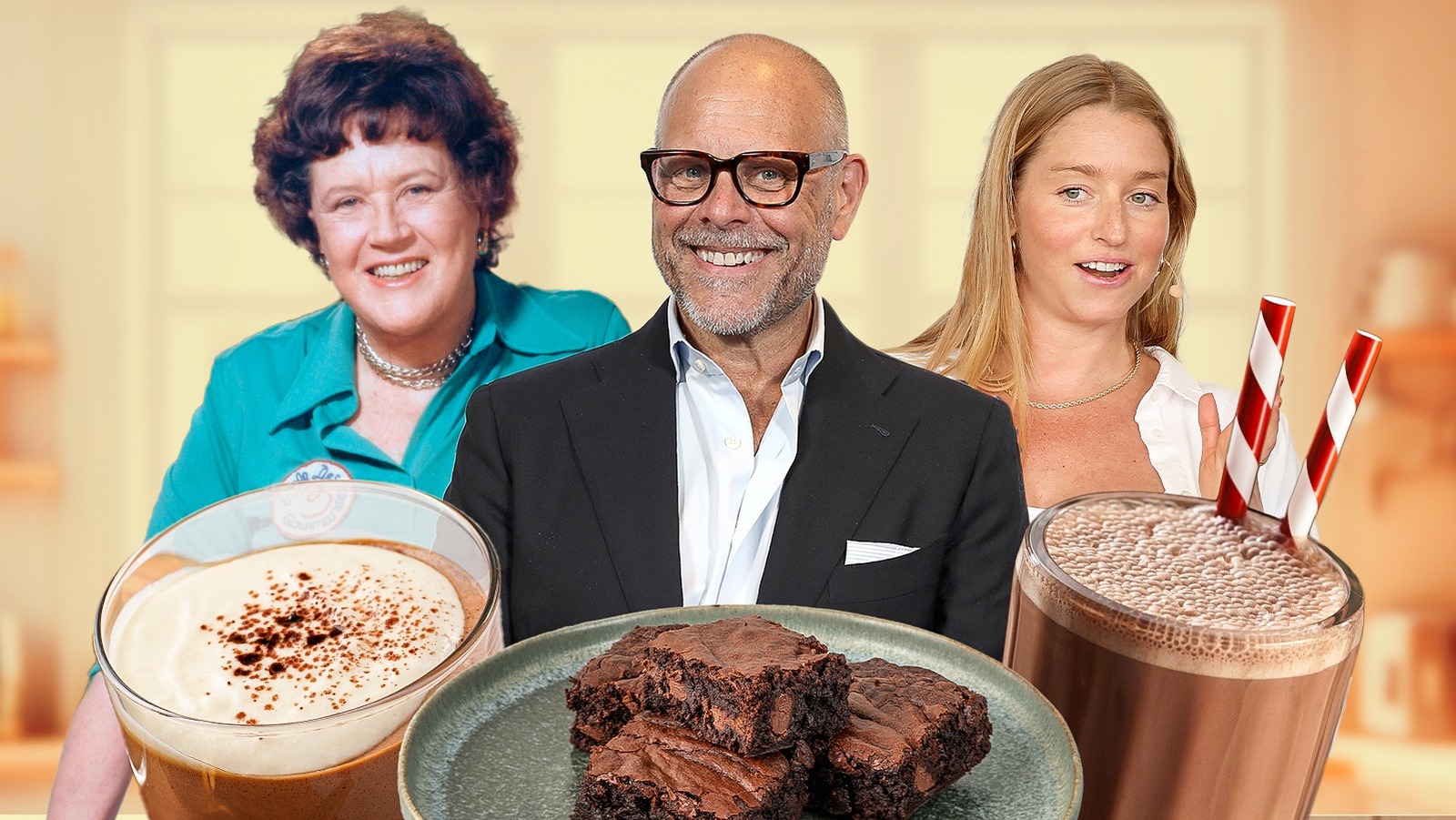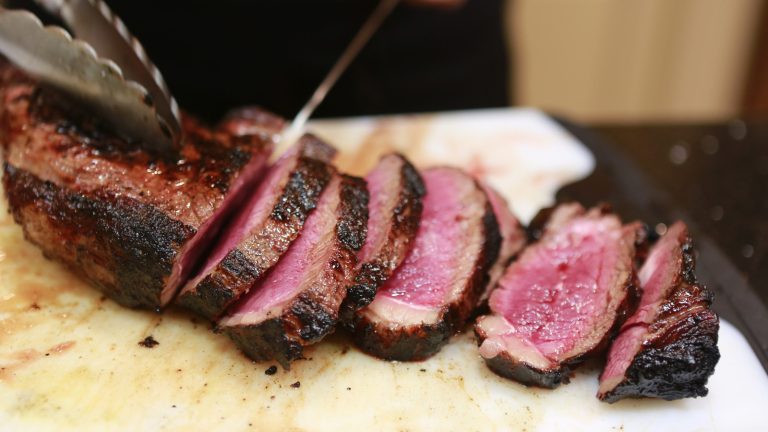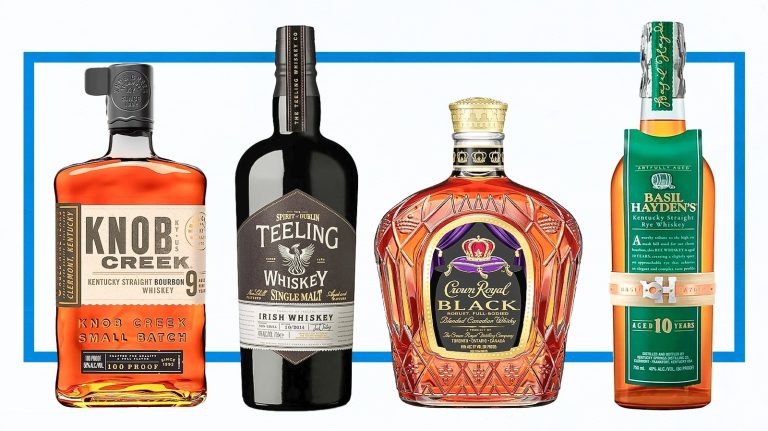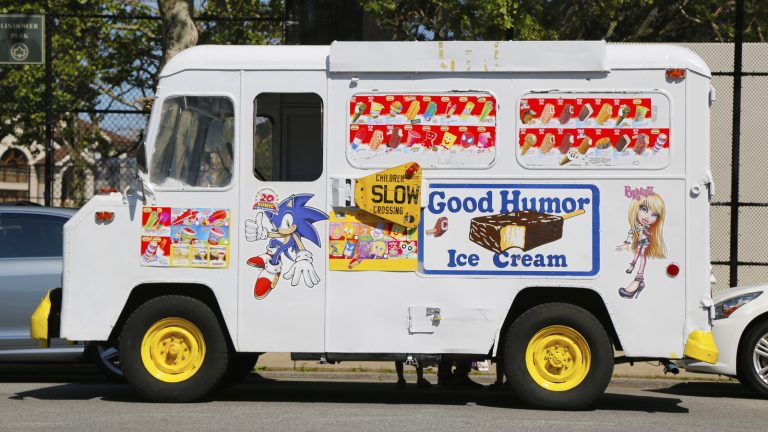Like salt, butter, sugar, and vinegar, chocolate is a landmark ingredient almost every chef and home cook keeps in their recipe repertoire. Utilizing the coveted, rich morsel in inventive applications has created now-standard dishes like brownies, and imagining a world without chocolate lurking on nearly every dessert list feels impossible. Whether it lurks in America’s favorite dessert, the chocolate chip cookie, a nostalgic chocolate pudding, or even savory dishes like Oaxacan mole, chocolate remains one of the most essential ingredients in any chef’s arsenal.
No wonder, then, how countless award-winning, world-recognized, and celebrity chefs all hone recipes dedicated to the world’s beloved bean. To commemorate some of the recipes that help make 15 celebrated, celebrity chefs solidify their kitchen stardom, we culled together a shortlist of the chocolate-laden recipes in their culinary playbooks.
From the all-American chocolate chip cookie to an off-the-wall chocolate pasta popularized on Instagram and a viral TikTok candy bar, we explored both the history behind each iconic chocolate creation and the celebrity chef who either invented the dish or concocted a variation all their own.
Double Chocolate cake from Ina Garten
A decadent, monochromatic, layered, double chocolate cake conjures images of classic diners and birthday parties, and every home baker worth their salt (and sugar) should have a trusted recipe on hand. First released on her now iconic cooking blog The Barefoot Contessa, then later immortalized in her 2006 cookbook “The Barefoot Contessa at Home,” Beatty’s Chocolate Cake might be the internet’s favorite chocolate cake recipe. Named after Garten’s longtime friend (and florist) Michael Grim’s grandmother, the cake recipe’s origins date back to a Pennsylvanian milk route and the cake grandma Beatty baked to accompany her deliveries.
Under Garten’s tutelage, the recipe now serves as countless Contessa fans’ go-to birthday cake. Incorporating cocoa powder, buttermilk, and other likely cake ingredients (eggs, sugar, flour, etc), Beatty’s cake also brings the surprising jolt of a single cup of brewed, hot coffee.
Topped in another layer of chocolate, the cake also receives a second helping of cacao via its silky, chocolate buttermilk frosting, which also hides a hint of instant espresso in its whip. With only two layers, Garten’s iconic cake not only tastes like a slice of utopia but also won’t intimidate an intermediate baker who can patiently put the beauty of Beatty together.
Molten lava cake by Jean-Georges Vongerichten
Anyone who remembers dining in the late 90s and early 00s recalls the gooey pleasure of running a fork through a molten chocolate cake. Invented in 1997, Jean-Georges Vongerichten claims to have invented the game-changing chocolate dessert at his eponymous restaurant, which still sits on the ground floor of the Trump International Hotel and Tower in New York City’s Central Park West neighborhood. Infinitely imitated, cooking websites worldwide look to Vongerichten’s miniature cake for inspiration.
The six-ingredient confection boasts a crispy exterior and gives way to a warm, dripping chocolate center, seeping into a vanilla ice cream mound. A near-perfect finale to a fine-dining experience, the cake (along with Ruth Reichl’s four-star review for The New York Times) helped make Jean-George a name recognized in foodie communities everywhere. The now-famed cake was quickly imitated by high and low-end restaurants alike, including Chili’s, and today, even boxed cake mixes boast the “molten lava” label in honor of Jean-Georges’ creation.
Since the cake’s debut, Chef Vongerichten added 26 restaurants to his empire within the United States, and 20 other kitchens scattered worldwide, and though his molten lava cake may harken back to a bygone era, its juxtaposition of texture and temperature will forever remain iconic.
Chocolate Mousse by Julia Child
Perhaps the most celebrated celebrity of all time, Julia Child’s cooking guidance on her revolutionary cooking show “The French Chef,” which ran from 1962-1973, ushered a universe of French cuisine into American households. Through her weekly program, Child demystified French cooking, including the country’s renowned patisseries.
In one of the show’s most iconic episodes, Child instructs, in real-time, her audience on how to pull off a perfect chocolate custard, or mouse. Shot live to videotape, “The French Chef” forced Child to perfect her recipes to the runtime of the show, therefore tasking herself with the tiring exercise of whisking eggs by hand for over five televised minutes. Shockingly slow by today’s television standards, Child’s live directives (which are available on YouTube) gave viewers an accurate depiction of the tedium and precision it takes to accomplish a perfect mousse.
A recipe complex in flavor yet simple if followed to the tee, Child’s own recipe chocolate mousse requires absolutely no baking whatsoever, only requiring four hours of rest time for the chocolate mixture to set into a satin-like dessert. Made of separated eggs, semi-sweet chocolate, and plenty of butter, the near-magic trick of a dessert continues to wow over half a century since its debut.
Brownies by Alton Brown
If there’s anything more cozy and inviting than a plate of rich homemade chocolate brownies, we haven’t yet tasted it. A marriage of a cookie’s sheetpan simplicity and a cake’s sustained popularity, the brownie owes its invention to Chicago-based socialite and philanthropist Bertha Palmer, who instructed her Palmer House pastry chefs to bring to life an easily transportable sweet for boxed lunches. The brownie premiered in 1893, grew in popularity throughout the 1900s, and remains one of America’s favorite chocolate-laden desserts more than 100 years later.
Debates of preference always permeate conversations surrounding the brownie: frosting or no frosting, served hot or at room temperature, cakey or slightly undercooked. However, its centrality to chocolate-lovers’ kitchens persists. Alton Brown, host of the long-running Food Network show “Good Eats,” author of eight cookbooks, and self-described food-science enthusiast, promises his brownie recipe proves “technique is just as important as ingredients. His unique twice-baked method asks readers to pop the batter into the oven for 15 minutes, allow for the brownies to cool for another 15, and then return the pan to bake for the remaining half hour. While Brown’s ingredient list contains all the usual suspects (sugar, cacao powder, butter, vanilla extract, eggs), his process ensures a thicker variation, with a flaky crust and fudgey center.
Chocolate pasta from Giada De Laurentiis
Not quite a ubiquitous hit like chocolate chip cookies or hot cocoa, this odd yet intriguing assemblage of chocolate and pasta is something of a cult classic. But like indie bands and movies, the unlikely Italian dish comes with hordes of intense devotees, among them, beloved Italian cookbook author and television host Giada De Laurentiis. Like perhaps chocolate’s most famed savory application, mole, Italians routinely employ the brown bean to create dimension in non-dessert dishes such as risotto, polenta, meats, and pastas.
Chocolate pasta, or pasta di cacao, can either include the chocolate component in the dough itself, dying the noodles an auburn tone, or simply incorporate melted chocolate into plain pasta sauce to impart the chocolate notes.
De Laurentiis opted for the latter when creating her viral Instagram recipe, where she asked followers, “Who is brave enough to try my favorite childhood snack, chocolate pasta?!?”. Though the celebrity chef quite literally was stirring the pot as she nudged audiences to recreate her mother’s specialty treat by adding either Nutella spread or melting chocolate chips into a bowl of pasta shells, she also offers a more complicated recipe on her official website, furthering her mission to kickstart a “chocolate pasta movement” within the food community.
Chocolate cocktail by Sam Ross
Though the origins of the first-ever chocolate martini point to it being the unlikely brainchild of two of Hollywood’s glitziest stars, Elizabeth Taylor and Rock Hudson, variations of the drink now permeate cocktail bars and internet recipe rosters everywhere. As the 1980s birthed the now resurgent Espresso Martini, and the 90s can be held responsible for the Appletini, Hollywood elite have nudged martini variations to borrow beloved ingredients and whirl them into drinkable desserts. Long after the 1955 “Giant” costars wrapped their movie, renowned beverage director Sam Ross tweaked the dessert-like original chocolate martini into a spirit-forward beverage meant to impress cocktail lovers.
The original chocolate martini recipe asks for cream (or half and half), vodka, chocolate syrup, creme de cacao, and chocolate liquor. Ross’ creation resembles a chocolate-infused boulevardier. Bourbon whiskey, Campari, sweet vermouth, and chocolate bitters round out the delicately balanced Left Hand cocktail from the same mind that brought to life contemporary classic cocktails such as the Paper Plane and Penicillin. A more subtle reading of Taylor and Hudson’s literal embodiment of a chocolate martini, the Attaboy co-owner smartly updated how chocolate fiends imbibe on the infinitely crave-able ingredient.
Chocolate bar by Sarah Hamouda
In nearly every grocery store across the United States, countless popular mass-produced chocolate bars beckon to shoppers. Filled with nougat, caramel, cookie, ruffled rice, and innumerable other tidbits, the candy bar as we know it has persistent mass appeal. The origins of the chocolate bar date back to 1847, when chocolatier J.S. Fry molded cocoa butter and sugar into an edible brick, and years later, in 1876, Daniel Peter added dried milk powder to the recipe. By the 20th century, competing American chocolatiers Hershey’s, Cadbury, and Mars all rose to prominence, solidifying the candy into an eternally crave-worthy delight.
And like every classic dish, fans of chocolate bars are forever dreaming up innovative interpretations on the chocolate bar, including the recently viral Dubai Knafeh Chocolate Bar. Sarah Hamouda, creator of FIX Dessert Chocolatier, went viral in 2023 for her chocolate bar filled with Brat-green pistachio filling. With only three ingredients, chocolate, pistachio cream, and kataifi (strings of toasted, crunchy pastry), Hamouda’s invention hits textural, salty, and sweet notes, resulting in a confection that quickly inspired imitators across the internet. Not yet the instantly-conjurable melding of flavors like a Snickers bar or KitKat, the popularity of the knafeh bar continues to grow as chocolatiers recreate TikTok’s beloved bar.
Chocolate chip cookie from Molly Baz
America’s favorite cookie, the chocolate chip cookie exists in more forms and recipes than count. A spread dedicated to the enduring cookie often occupies cookbook volumes, as chefs and home cooks alike seek to perfect the golden, gooey delight. Store-bought variations of Ruth Graves Wakefield 1930 original recipe line the cookie aisles of grocery store from recognizable brands like Chips Ahoy and Pepperidge Farms, and celebrities including Martha Stewart, Chrissy Tiegan, and even Michelle Obama have all dedicated time and energy to producing their own riffs on the formula.
However, it’s “Bon Appétit” alum Molly Baz’s Pistachio Brown Butter and Halva Chocolate Chunk cookie that has us preheating our oven. Not only does Baz’s cookie boast a crispy cookie circumference and a soft middle, but her creation also adds trendy, Arabic ingredients like halva and pistachios. The result has been hailed as “The Internet’s Favorite Chocolate Chip Cookie,” only furthering the momentum that Baz’s popularity and notoriety have accrued. The once behind-the-scenes recipe tester now can claim cookbook author, wine maker, vegan burger shop, and most recently, condiment brand owner to her growing list of culinary achievements, though her viral chocolate chip cookie recipe remains the nearest to our hearts.
Blondies by Gordon Ramsay
Though milk and dark chocolate receive the lion’s share of the love, their pale sibling, white chocolate, also inspires bakers to invent sweet treats. Most notably, the blondie followed its dark chocolate predecessor with a tawny riff on a brownie. While dark chocolate receives its color and flavoring from cacao solids, white chocolate combines cacao butter, milk, and sugar to achieve the ivory treat.
Only three brief years after the original brownie was invented, Fannie Farmer published the first-ever blondie recipe in her 1896 volume “The Boston Cooking School Cookbook.” With a nearly identical ingredient list to a brownie, Farmer’s invention simply swapped out brown chocolate chips for white chocolate chips to achieve a novel, more niche rendition of the classic, chocolate square.
A blonde himself, Gordon Ramsay of “Hell’s Kitchen” and several other widely-watched food-centric television programs, released his take on the golden dessert in an episode of his 2013 “Ultimate Cookery Course.” Similar to Farmer’s inaugural blondie recipe, Ramsay calls for white chocolate, butter, brown sugar, vanilla extract, but adds a colorful handful of dried cranberries to create a buoyant, tart note to the chewy, sand-colored dessert.
Chocolate milkshakes from Christina Tosi
A symbol of both a bygone era and young love, the milkshake’s origins date back to 1922, after the invention of electric blenders made the time-sensitive milk and ice cream hybrid possible. The brain-freeze-inducing treat debuted, wildly enough, at an early Walgreens location after an employee, Ivar “Pop” Coulson, popped both malted milk and ice cream into the pharmacy’s house blender.
Today, variations of Coulson’s invention exist everywhere from diners to fast-food chains like In-and-Out, McDonald’s, and Dairy Queen. Being able to satiate chocolate cravings through a straw not only makes the drink transportable, but also simultaneously shareable, as the image of two lovebirds sharing a tall, milkshake, poured into a frosted glass exists as a cultural touchstone of 1950s teenage courtship.
A milkshake enthusiast and one of America’s most celebrated pastry chefs, Christina Tosi, not only compiled a shortlist of her favorite milkshake vendors in New York City, but’s also contributed to the canon of recipes in her Milk Bar collaboration with the national burger chain, Shake Shack. In 2021, Tosi launched two new milkshakes into the world. The Chocolate Birthday Cake Shake uses Shake Shack’s chocolate custard, Milkbar’s vanilla frosting, birthday crumbs, and the Cornflake Chocolate Drizzle Shake, which contains vanilla custard, chocolate fudge, and miniature marshmallows.
Hot Chocolate from Jacques Torres
One of the oldest known chocolate recipes, hot chocolate (or cocoa) dates back thousands of years to Aztec and Mayan cultures. Though not recognizable as the hot chocolate we know today, ancient Mayans would grind cacao seeds with water, cornmeal, and chili. Far from the whipped cream-topped delicacy widely enjoyed during wintertime months, humanity’s first drinkable chocolate, though heated during preparation, was likely served cold.
Another iconic dish (or drink), ranging from mass-market powdered mixes to artisanal cafe creations, cups of hot chocolate comfort their drinkers by swaddling them in creamy, rich chocolate and a dose of sweetness.
French pastry chef and chocolatier, Jacques Torres, has written a compendium of chocolate recipes, including petit fleurs, chocolate lollipops, tuffles, and even a chocolate picture frame. But his hot chocolate scratches chill-weather chocolate cravings with barely any legwork. Made from his own Mr. Chocolate 60% dark chocolate discs, whole milk, milk powder, and cornstarch, Torres’ signature hot cocoa only asks for its readers to thoroughly whisk chopped nibs into milk until melted, and add the remaining powders until silky smooth — a process that can be completed in under 10 minutes. Torres also suggests zhuzhing up his basic hot cocoa with chocolate-friendly ingredients like mint, orange, vanilla, and more.





